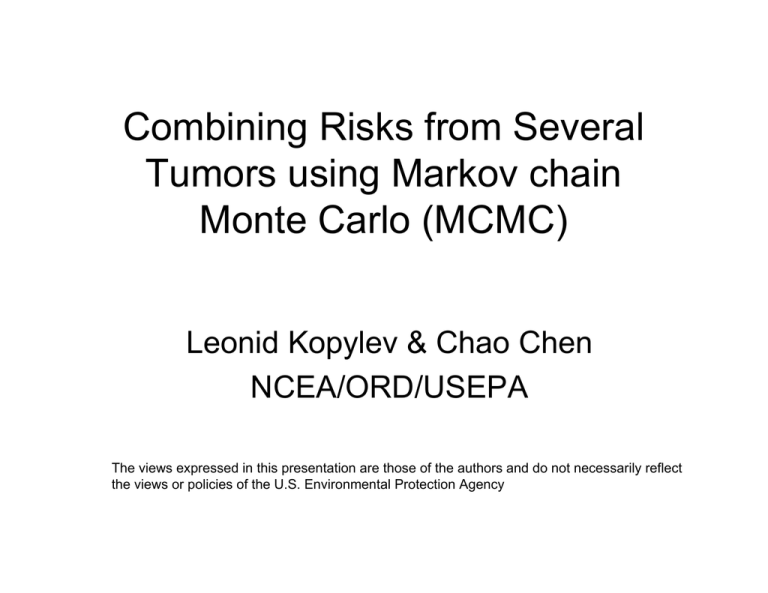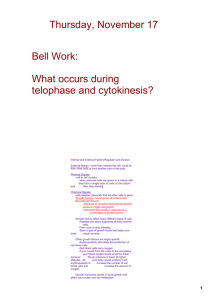Combining Risks from Several Tumors using Markov chain Monte Carlo (MCMC)
advertisement

Combining Risks from Several Tumors using Markov chain Monte Carlo (MCMC) Leonid Kopylev & Chao Chen NCEA/ORD/USEPA The views expressed in this presentation are those of the authors and do not necessarily reflect the views or policies of the U.S. Environmental Protection Agency Combined Risk from Multiple Tumor Sites How does one estimate the combined risk and, if needed, the corresponding benchmark dose for multiple tumor sites? Risks from multiple tumors occur for many carcinogens, and there is a need for statistical methods and the corresponding software tools to implement those. History National Research Council. Science and judgment in risk assessment, 1994 (based on earlier work by Ken Bogen): “…a general assumption of statistical independence of tumor-type occurrences within animals is not likely to introduce substantial error in assessing carcinogenic potency” Criticized a procedure used in an EPA assessment based on pooling tumor-bearing animals Recommended re-sampling approach, as it provides distribution of the combined potency Note: this discussion is for the summary data, as in Nectorine example. If data on individual animals is available, other approaches are possible. Multistage Model For the multistage model: PA(d) = PB(d) = PAorB(d) = PAorB(d) = 1 – exp(-(β0A + β1A*d + … + βkA*dk)) 1 – exp(-(β0B + β1B*d + … + βmB*dm)) PA(d) + PB(d) – PA(d) * PB(d) 1–exp(-(β0A+β0B + (β1A+β1B)*d +…+ βkA*dk + βmB*dm)) Extra Risk: ERAorB(d) = (PAorB(d) – PAorB(0))/ (1 - PAorB(0)) ERAorB(d) = 1 – exp(-[(β1A+β1B)*d +…+ βkA*dk+βmB*dm]) Hence, BMD for combined risk BMRAorB is the solution to the polynomial -log(1-BMRAorB)= (β1A+β1B)*d +…+ βkA*dk+βmB*dm Similarly for other models (but with more complex expressions) Computing Approaches • BMDS software allows computation of BMD corresponding to combined risk, using polynomial above, but not confidence bounds (BMDL) • Method used in BMDS software – profile likelihood – can be conceptually extended from one tumor to several and BMDS developers are working on this, but there is no software yet • Bayesian approach using MCMC software WinBugs. One benefit is that distribution of BMD or risk itself is obtained allowing more information or further characterization of uncertainty than would calculation of only the confidence bounds and/or MLE. MCMC approach • Models for dichotomous data are easily implemented in Winbugs software • Application to multistage model for a single tumor described in: L.Kopylev, C.Chen, P. White (2007) “Towards quantitative uncertainty assessment for cancer risks: central estimates and probability distributions of risk in dose-response modeling”, Regulatory Toxicology and Pharmacology (in press) • Extension to several tumors using NRC (1994) recommendations is straightforward. • A diffuse (high variance or low tolerance) Gaussian prior restricted to be nonnegative was used. The posterior distribution is based on 3 chains of 550,000 simulations; with 50,000 burn-in (50,000 initial simulations dropped) and thinning rate of 10, resulting in 150,000 simulations. Nectorine Data Tumor type Concentration (ppm) 0 10 30 60 Respiratory epithelial adenoma 0/49 6/49 8/48 15/48 Olfactory epithelial neuroblastoma 0/49 0/49 4/48 3/48 Linear multistage model fits better (lower DIC) than quadratic or cubic model for both adenoma and neuroblastoma tumors based on WinBugs calculations Similarly, linear model is preferable in BMDS setup based on lowest AIC. The mean and 5th percentile of the posterior distribution provide estimates of the mean BMD and the BMDL for combined tumor risk, respectively Combining Risks for Nectorine Nectorine Distribution of Log10(BM D10) for individual and combined tumors 0 1 2 Density 3 4 5 adenoma neuroblastoma combined B B 0.5 1.0 B 1.5 2.0 Log10(D ose) 2.5 3.0 3.5 Adding Tumors vs. Combining Risks Adding tumors and fitting a model to the resulting data is done in other position papers. Here we examine the difference with our method. Tumor type Concentration (ppm) 0 10 30 60 Respiratory epithelial adenoma 0/49 6/49 8/48 15/48 Olfactory epithelial neuroblastoma 0/49 0/49 4/48 3/48 Tumors added 0/49 6/49 12/48 18/48 but it is different approach from probabilistically combining risks of individual tumors to arrive at the risk of at least one tumor. We used the same MCMC approach to fit multistage model to the added tumors data to illustrate difference between two approaches. Adding Tumors vs. Combining Risks for Nectorine 0.20 Nectorine Comparison of combining tumors vs. adding tumors 0.10 0.05 0.00 Density 0.15 added combined BB 0 10 20 D ose 30 40 Benefits and Limitations - Provides distribution of the combined potency. Beneficial, compared to point estimates - Uncertainty given the particular risk model - Does not address uncertainty associated with the selection of the particular model - Assumes independence of tumors given dose. Independence may or may not be true. An investigation of consequences of violation of independence assumption is in the works.







